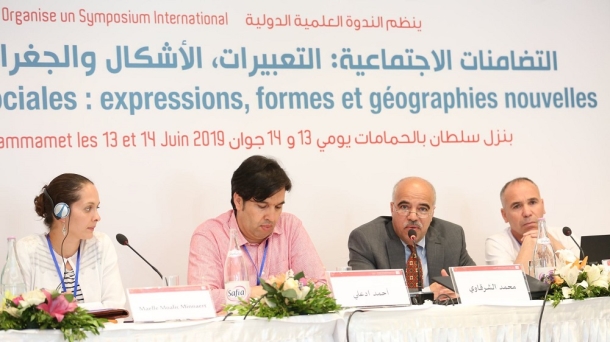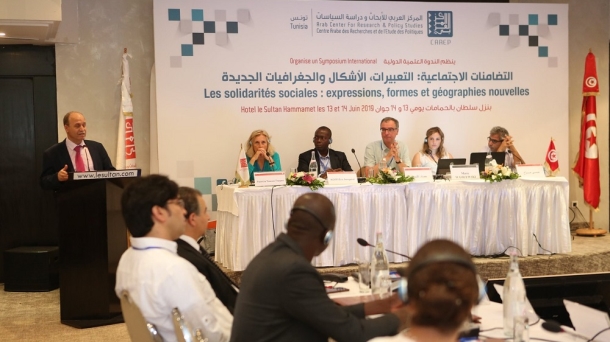
The Arab Center for Research and Policy Studies in Tunis gathered about thirty researchers from Tunisia, Algeria, Morocco, Mauritania, Côte d'Ivoire, France, and the United States in an international symposium, at the city of Hammamet June 13 and 14, 2019, to discuss "Social Solidarity: New Expressions, Forms and Geographies". The symposium included seven sessions focusing on various themes "Theories, concepts, the transformation of semantics", "The social roles of solidarity", "The economic roles of solidarity", "The places of solidarity and its new geography" and "Transformations of traditional solidarity".
In his presentation, Dr. Mohammed Cherkaoui, senior researcher at Aljazeera Center for Studies (AJCS) and professor of Conflict Resolution at George Mason University (GMU), sought to develop a new theory of solidarity. He argues solidarity derives from the interconnectedness between context and trajectory, two main components that captures three main points:
1) The relationship between oneself and his/her in-group, and vis-a-vis the out-group, along distant conceptualizations of solidarity between the East and the West. There are parallel constructs between what can be termed as Western contractualism, shaped by social contract theory of Hobbes and Rousseau, and Oriental relationalism as a group feeling behind the community-based we-ness.
2) Solidarity implies the restoration of values. It stands at the crossroads between the need for uniting individuals within a social nucleus that may turn into a strike, a demonstration, or the emergence of a social movement, such as the case of the Rif Movement in Morocco, and the common conviction and passion, which emerges from the utopian or idealistic spirit, moral discourse, and normative narratives in defending their demands.
3) Solidarity entails a trajectory of an alternative political project. The analysis of solidarity does not deviate from the duality of context and trajectory. As the relational aspect of the social group solidifies and the vital communication among them, as German philosopher Jürgen Habermas points out, solidarity becomes a vital force resisting the sustainability of the fait accompli, and challenges the asymmetrical power relations while promoting and justifying the discourse of change.
Cherkaoui probes into the reasons for the resurgence of solidarity within the Riffian community in northern Morocco and also among the Moroccan diaspora in Europe. Since the death of fish seller Mohsen Fikri inside a garbage truck in Al Hoceima on 28 October 2016, the conflict between the Moroccan authorities and the Hirak protests in the north of the country has turned into an open-ended confrontation. On 27 June 2018, Nasser al-Zafzafi and forty-nine fellow Rif activists received prison terms ranging between 20 and 3 years, totaling 300 years in prison. The Moroccan authorities released 11 detainees from Okasha prison after they signed an amnesty petition. King Mohammed VI responded positively to their release in the context of a royal amnesty on the occasion of Eid al-Adha on 21 August 2018.
The study also examines how the solidarity dialectic between discourse, nationalism and Riffian identity has strengthened its appeal in its areas of convergence/divergence with the discourse and the overall national identity in Morocco. It focuses on the dynamics of Rif conflict, as a case study, and aims at advancing the theory of solidarity within the semantic fields of other sciences (social psychology, political sociology, political science, and conflict resolution) drawing on Jürgen Habermas’s and Axel Honneth’s works on critical social theory.
Honneth identifies three ‘spheres of interaction’ which are connected to the three ‘patterns of recognition’ necessary for an individual’s development of a positive relation-to-self. These are love, rights, and solidarity.” (The Struggle for Recognition. The Moral Grammar of Social Conflicts. 1995). He draws on a theoretical framework that combines the framework of Hegel’s (1770-1831) theory of ‘struggle for recognition’ (kampf um anerkennung) and George H. Mead’s (1863-1931) theory of social interaction in self-formation, or what he termed as "social action", as a fundamental unit of analysis in the study of social existence. Honneth explains how “the reproduction of social life is governed by the imperative of mutual recognition, because one can develop a practical relation-to-self only when one has learned to view oneself, from the normative perspective of one’s partners in interaction, as their social addressee” (1992, p. 92).
Cherkaoui’s study adopts the logic of the Hegelian dialectic in understanding solidarity and recognition not as a fixed or stable given, but rather as a dynamic construct amidst the interaction between self-awareness and recognition of the other in both directions. It also represents a parallel psychological and social structure between the ‘in-group’ and the ‘out-group’. He argues that the momentum of high and low levels of solidarity lies mainly in the relational aspect within and beyond the social group, rather than the common awareness of the dynamism of the group from within. As Hegel argues, “Self-consciousness has before it another self-consciousness; it has come outside itself. This has a double significance. First it has lost its own self, since it finds itself as an other being; secondly, it has thereby sublated that other, for it does not regard the other as essentially real, but sees its own self in the other.”
If we adopt Jacques Derrida, the face of the other tends to be shaped "before solidarity" and "without partnership". The phenomenon of solidarity involves the interaction between two opposing social groups, and requires a parallel comparison of the strength and weakness of the solidarity of each group versus another. There can be no recognition of community solidarity outside the collective awareness of the existence of the other.
While reconstructing solidarity and recognition in Morocco’s Hirak conflict, the paper proposes a four-part theoretical framework to study the open-ended social conflict between the Moroccan authorities and Rifians, who have been marginalized because the legacy of their historical leader Abdelkarim al-Khattabi who defied the Spaniards in 1921 and declared his “Republic of the Rif” between 1921 and 1926. The paper aims to advance the concept of solidarity in conjunction with recognition. It draws on Ibn Khaldoun’s asabiya as a strong group feeling among Rifians in the wake of recent events and trials of the activists who have gone back to their chosen glory of 1921 as well as chosen traumas, that followed the crack-down of the authorities on their 1958-59 and 1984 revolutions. Their demands and pursuit of dignity both locally and among their diaspora in Europe have gone beyond the structural reforms the government is willing to implement with considerable budgets. Working with Western concepts from Fukuyama, Hegel, Taylor, Kojève, Levinas, Fraser, and Habermas, the paper demonstrates how important local concepts are to productive analysis of local conflicts.
 |
| [AlJazeera] |